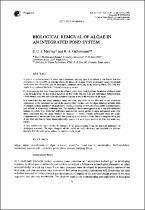JavaScript is disabled for your browser. Some features of this site may not work without it.
- ResearchSpace
- →
- Research Publications/Outputs
- →
- Journal Articles
- →
- View Item
| dc.contributor.author |
Meiring, PGJ

|
|
| dc.contributor.author |
Oellermann, RA

|
|
| dc.date.accessioned | 2007-06-12T07:45:15Z | |
| dc.date.available | 2007-06-12T07:45:15Z | |
| dc.date.issued | 1995 | |
| dc.identifier.citation | Meiring, PGJ and Oellermann, RA. 1995. Biological removal of algae in an integrated pond system. Water Science and Technology, vol. 31(12), pp 21-31 | en |
| dc.identifier.issn | 0273-1223 | |
| dc.identifier.uri | http://hdl.handle.net/10204/573 | |
| dc.description | Copyright: 1995 Pergamon-Elsevier Science Ltd | en |
| dc.description.abstract | A system of oxidation ponds in series with a biological trickling filter is described. It was known that this arrangement was incapable of reducing effectively the levels of algae present in the pond liquid even though nitrification was effected because of autotrophic conditions prevailing in the trickling filters. This very low tropic level explained the lack of adsorptive capacity present. By short-circuiting less than 10 percent of the effluent from a fully loaded primary facultative oxidation pond to the trickling filter, the autotrophic nature or the film in the trickling filter was sufficiently shifted towards a heterotrophic state that had sufficient adsorptive capacity to retain the majority of the algae. It is concluded that the algae, although being absorbed, stay alive on the film and do not contribute significantly to the carbonaceous load on the trickling filter. Further more the algae, although secluded from all sunlight, actually partake in the purification process, producing an effluent which, unlike a normal humus tank effluent, is surprisingly sparkling clear. This significant observation appears to be in line with laboratory findings by others who, when they artificially immobilised certain species of algae and passed water over them, concluded that the algae retained the potential to remove certain compounds from the water. Conglomerates of biologically flocculated dark-green algae are scoured off the film (or sloughed off as part of the film) and having been photosynthetically inactive for some days, tend not to neat, but settle very rapidly. A very significantly aspect of this development is the great potential it has for practical application in developing countries. The algae sloughed off the media are easily thickened and available for ultimate recovery from the water phase without the addition of chemicals. | en |
| dc.language.iso | en | en |
| dc.publisher | Pergamon-Elsevier Science Ltd | en |
| dc.subject | Algae immobilization | en |
| dc.subject | Algae removal | en |
| dc.subject | Anaerobic pond-reactor | en |
| dc.subject | Autotrophic | en |
| dc.subject | Bio-flocculation | en |
| dc.subject | Facultative | en |
| dc.subject | Heterotrophic | en |
| dc.subject | Oxidation ponds | en |
| dc.subject | Petro process | en |
| dc.subject | Trickling filters | en |
| dc.title | Biological removal of algae in an integrated pond system | en |
| dc.type | Article | en |
| dc.identifier.apacitation | Meiring, P., & Oellermann, R. (1995). Biological removal of algae in an integrated pond system. http://hdl.handle.net/10204/573 | en_ZA |
| dc.identifier.chicagocitation | Meiring, PGJ, and RA Oellermann "Biological removal of algae in an integrated pond system." (1995) http://hdl.handle.net/10204/573 | en_ZA |
| dc.identifier.vancouvercitation | Meiring P, Oellermann R. Biological removal of algae in an integrated pond system. 1995; http://hdl.handle.net/10204/573. | en_ZA |
| dc.identifier.ris | TY - Article AU - Meiring, PGJ AU - Oellermann, RA AB - A system of oxidation ponds in series with a biological trickling filter is described. It was known that this arrangement was incapable of reducing effectively the levels of algae present in the pond liquid even though nitrification was effected because of autotrophic conditions prevailing in the trickling filters. This very low tropic level explained the lack of adsorptive capacity present. By short-circuiting less than 10 percent of the effluent from a fully loaded primary facultative oxidation pond to the trickling filter, the autotrophic nature or the film in the trickling filter was sufficiently shifted towards a heterotrophic state that had sufficient adsorptive capacity to retain the majority of the algae. It is concluded that the algae, although being absorbed, stay alive on the film and do not contribute significantly to the carbonaceous load on the trickling filter. Further more the algae, although secluded from all sunlight, actually partake in the purification process, producing an effluent which, unlike a normal humus tank effluent, is surprisingly sparkling clear. This significant observation appears to be in line with laboratory findings by others who, when they artificially immobilised certain species of algae and passed water over them, concluded that the algae retained the potential to remove certain compounds from the water. Conglomerates of biologically flocculated dark-green algae are scoured off the film (or sloughed off as part of the film) and having been photosynthetically inactive for some days, tend not to neat, but settle very rapidly. A very significantly aspect of this development is the great potential it has for practical application in developing countries. The algae sloughed off the media are easily thickened and available for ultimate recovery from the water phase without the addition of chemicals. DA - 1995 DB - ResearchSpace DP - CSIR KW - Algae immobilization KW - Algae removal KW - Anaerobic pond-reactor KW - Autotrophic KW - Bio-flocculation KW - Facultative KW - Heterotrophic KW - Oxidation ponds KW - Petro process KW - Trickling filters LK - https://researchspace.csir.co.za PY - 1995 SM - 0273-1223 T1 - Biological removal of algae in an integrated pond system TI - Biological removal of algae in an integrated pond system UR - http://hdl.handle.net/10204/573 ER - | en_ZA |






